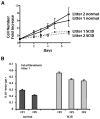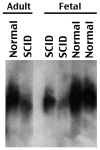SCID dogs: similar transplant potential but distinct intra-uterine growth defects and premature replicative senescence compared with SCID mice
- PMID: 19635917
- PMCID: PMC4047667
- DOI: 10.4049/jimmunol.0801406
SCID dogs: similar transplant potential but distinct intra-uterine growth defects and premature replicative senescence compared with SCID mice
Abstract
We have previously described DNA-dependent protein kinase (DNA-PKcs) mutations in horses and dogs that result in deficits in V(D)J recombination, DNA repair, and SCID. In this paper, we document substantial developmental growth defects in DNA-PKcs-deficient dogs that are not apparent in SCID mice. Fibroblast cell strains derived from either fetal or adult SCID dogs proliferate poorly in culture and undergo premature replicative senescence, somewhat reminiscent of cells derived from Ku-deficient mice. A limited number of animals have been immune reconstituted (by bone marrow transplantation) so that they can be maintained in a normal environment for long periods. Several of these animals have developed conditions associated with premature ageing at 2-3 years of age, roughly 20% of their expected lifespan. These conditions include intestinal malabsorption and primary neural cell neoplasia. These results suggest that DNA-PKcs deficiency is not tolerated equally in all species, perhaps providing insight into why DNA-PKcs deficiency has not been observed in humans. Finally, this study demonstrates the feasibility of maintaining SCID dogs for extended periods of time and documents their utility for bone marrow transplantation studies and as hosts for the propagation of xenografts. In sum, SCID dogs may present researchers with new possibilities for the development of animal models of human disease.
Conflict of interest statement
The authors have no financial conflict of interest.
Figures






Similar articles
-
SCID in Jack Russell terriers: a new animal model of DNA-PKcs deficiency.J Immunol. 2001 Aug 15;167(4):2142-50. doi: 10.4049/jimmunol.167.4.2142. J Immunol. 2001. PMID: 11489998
-
Targeted disruption of the Artemis murine counterpart results in SCID and defective V(D)J recombination that is partially corrected with bone marrow transplantation.J Immunol. 2005 Feb 15;174(4):2420-8. doi: 10.4049/jimmunol.174.4.2420. J Immunol. 2005. PMID: 15699179
-
Analyses of TCRB rearrangements substantiate a profound deficit in recombination signal sequence joining in SCID foals: implications for the role of DNA-dependent protein kinase in V(D)J recombination.J Immunol. 2000 Feb 1;164(3):1416-24. doi: 10.4049/jimmunol.164.3.1416. J Immunol. 2000. PMID: 10640757
-
DNA-PKcs deficiency in human: long predicted, finally found.Curr Opin Allergy Clin Immunol. 2009 Dec;9(6):503-9. doi: 10.1097/ACI.0b013e3283327e41. Curr Opin Allergy Clin Immunol. 2009. PMID: 19823081 Review.
-
Molecular pathology of severe combined immunodeficiency in mice, horses, and dogs.Vet Pathol. 2004 Mar;41(2):95-100. doi: 10.1354/vp.41-2-95. Vet Pathol. 2004. PMID: 15017021 Review.
Cited by
-
PRKDC mutations in a SCID patient with profound neurological abnormalities.J Clin Invest. 2013 Jul;123(7):2969-80. doi: 10.1172/JCI67349. Epub 2013 Jun 3. J Clin Invest. 2013. PMID: 23722905 Free PMC article.
-
Engraftment of human iPS cells and allogeneic porcine cells into pigs with inactivated RAG2 and accompanying severe combined immunodeficiency.Proc Natl Acad Sci U S A. 2014 May 20;111(20):7260-5. doi: 10.1073/pnas.1406376111. Epub 2014 May 5. Proc Natl Acad Sci U S A. 2014. PMID: 24799706 Free PMC article.
-
Targeting DNA-PK.Cancer Treat Res. 2023;186:299-312. doi: 10.1007/978-3-031-30065-3_16. Cancer Treat Res. 2023. PMID: 37978142 Free PMC article.
-
Compared to other NHEJ factors, DNA-PK protein and RNA levels are markedly increased in all higher primates, but not in prosimians or other mammals.DNA Repair (Amst). 2024 Oct;142:103737. doi: 10.1016/j.dnarep.2024.103737. Epub 2024 Aug 8. DNA Repair (Amst). 2024. PMID: 39128395
-
Loss of mitochondrial peptidase Clpp leads to infertility, hearing loss plus growth retardation via accumulation of CLPX, mtDNA and inflammatory factors.Hum Mol Genet. 2013 Dec 15;22(24):4871-87. doi: 10.1093/hmg/ddt338. Epub 2013 Jul 12. Hum Mol Genet. 2013. PMID: 23851121 Free PMC article.
References
-
- Fischer A, Le Deist F, Hacein-Bey-Abina S, Andre-Schmutz I, de Basile SG, de Villartay JP, Cavazzana-Calvo M. Severe combined immunodeficiency: a model disease for molecular immunology and therapy. Immunol Rev. 2005;203:98–109. - PubMed
-
- Shin EK, Perryman LE, Meek K. A kinase-negative mutation of DNA-PK(CS) in equine SCID results in defective coding and signal joint formation. J Immunol. 1997;158:3565–3569. - PubMed
-
- Taccioli GE, Rathbun G, Oltz E, Stamato T, Jeggo PA, Alt FW. Impairment of V(D)J recombination in double-strand break repair mutants. Science. 1993;260:207–210. - PubMed
Publication types
MeSH terms
Grants and funding
LinkOut - more resources
Full Text Sources
Medical

